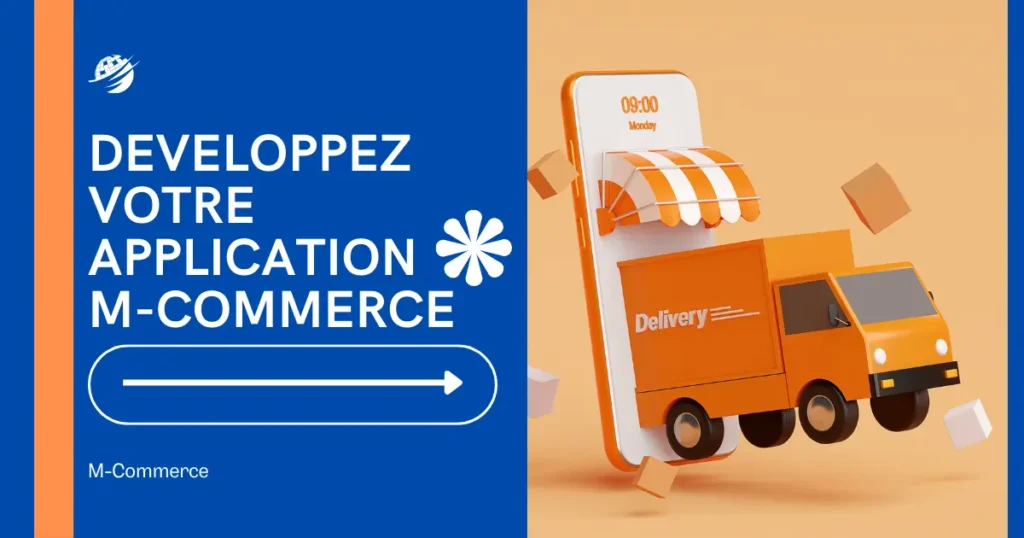Imagine discovering upon awakening that your conventional retail establishment is teeming with patrons from throughout the world, all of whom are completing transactions with a single tap on their iPhones. This is not a pipe dream mobile commerce, or m-commerce, is here to stay. Creating a successful developpez votre application m-commerce is a highly attractive prospect as customer behavior turns more and more towards mobile buying.
Why Create an Application for M-Commerce?
Quick Response
Using the growing trend of consumer mobile usage, developing an m-commerce application may dramatically increase revenues, improve customer engagement, and offer a smooth purchasing experience.
Advantages of M-Commerce Applications: Higher Sales:
M-commerce drives up sales volumes by enabling clients to purchase whenever and wherever they choose. The United States’ mobile retail e-commerce market is expected to grow from $339.03 billion in 2020 to $728.28 billion by 2025, according to Statista.

Improved Customer Experience
A customized purchasing experience is offered by mobile apps. A better customer journey can be achieved with features like push notifications, personalized recommendations, and simple navigation.
Company Loyalty
Through special offers and incentive systems, an app gives users a direct line of communication with the company, fostering stronger bonds and brand loyalty.
A Successful M-Commerce Application’s Essential Elements
- User-Friendly Interface
Customers can utilize your app with ease if it has a smooth user interface (UI). Your target demographic should be catered for, and the design should be visually appealing and intuitive. - Safe Methods of Payment
Safety comes first. To safeguard client data, integrate reputable payment gateways and make sure you’re in compliance with security guidelines like PCI DSS. - Individualization
Make individualized recommendations based on user activity, past purchases, and interests by utilizing data analytics. - Quick Loading Times
A sluggish app may turn off users. Make sure your program is optimized for fast load times and seamless operation. - Push Alerts
Engage users with timely updates on new items, discounts, and special offers by sending them push notifications.
How to Write an M-Commerce Application
- Step 1: Planning and Market Research
To comprehend your target market, their preferences, and the competition, conduct in-depth market research. Establish specific goals for your app, such as raising revenue, enhancing user satisfaction, or reaching a wider audience. - Step 2: Select the Appropriate Platform
Choose between creating a web application, a hybrid app, or a native app. While hybrid apps are more affordable and build more quickly, native apps provide superior functionality and user experience. - Step 3: Conception and Modeling
To see the design and operation of the app, create wireframes and prototypes. To improve the design, get input from stakeholders and possible users. - Step Four: Creation
Select a dependable development framework and begin writing code. Make sure your app is scalable so it can accommodate an increase in the quantity of users and transactions. - Step Five: Examining
Carry out thorough testing to find and address bugs. Examine the app’s usability, security, and performance on various hardware and operating systems. - Step 6: Promotion and Launch
Install your software to app stores and advertise it via different platforms. To reach your target demographic, use paid advertising, social media marketing, and SEO.
Frequently Asked Questions About Creating an M-Commerce App
What is the price of creating an M-Commerce app?
The complexity of the program, its features, and the location of the development team all affect the price. It might be anything between $20,000 and $250,000 on average.
How much time does it take to create an app for m-commerce?
Depending on how complex the software is, development times vary. It can take three to six months to develop a basic app, and a year or longer for a comprehensive one.
On what platform ought I to build my mobile commerce application?
Select according to who your target market is. Create an iOS app initially if that’s where the majority of users are. As an alternative, think about developing a cross-platform software to appeal to Android and iOS customers.
How can I make sure my m-commerce app is secure?
Put strong security measures in place, such as data encryption, secure payment gateways, SSL certificates, and frequent security audits.
What m-commerce trends are we seeing right now?
Voice commerce, mobile wallets, AI-driven customisation, and augmented reality (AR) buying experiences are some of the current trends.
M-Commerce Statistics and Trends
| Statistic/Trend | Data/Insight |
|---|---|
| Global m-commerce sales | Expected to reach $3.56 trillion in 2021 (Statista) |
| Mobile share of total e-commerce sales | 72.9% by the end of 2021 (eMarketer) |
| Average order value (AOV) on mobile | 30% higher on mobile apps compared to mobile web (Criteo) |
| Voice commerce growth | Projected to reach $40 billion in the U.S. by 2022 (OC&C Strategy Consultants) |
| AR in m-commerce | 100 million consumers expected to shop using AR by 2022 (Gartner) |
Conclusion
Developing an m-commerce application is a strategic move to stay competitive in the digital marketplace. By leveraging the benefits of mobile technology, you can enhance customer experience, drive sales, and build brand loyalty. Follow the outlined steps and incorporate the essential features to create a successful m-commerce app that meets your business objectives. Stay updated with the latest trends and continuously improve your app to meet evolving customer needs.

